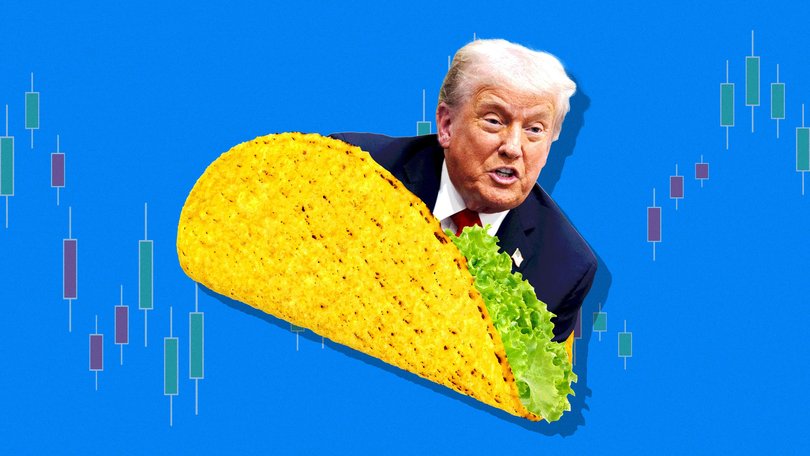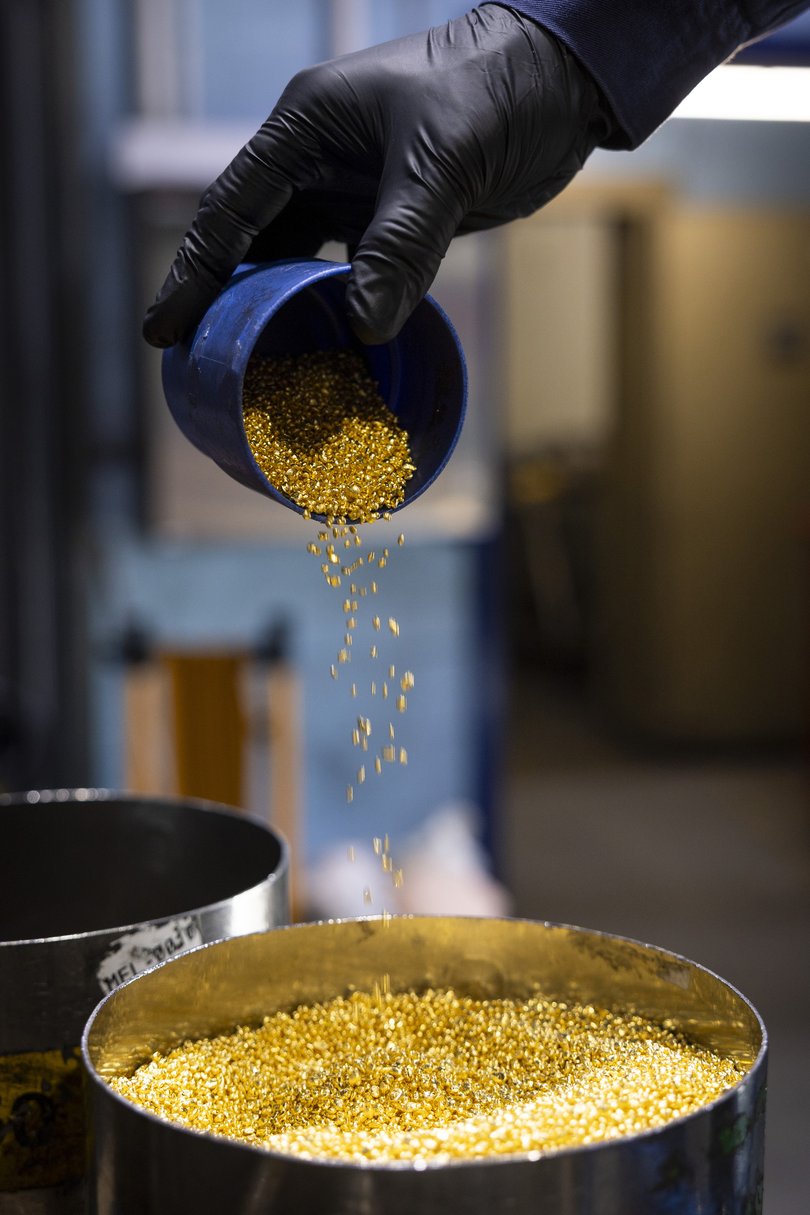Rare earths, real risks: How Donald Trump’s trade war is boosting gold, dividing the world

Stocks have climbed a wall of worry as the TACO (“Trump Always Chickens Out) trade returns. It’s the theory that investors should buy the dip to profit when stocks rise as the US backs down on tariff threats.
So far it’s worked. Stocks have surged since April 2. The S&P/ASX 200 hit a record high on Thursday and the tech-heavy Nasdaq Index has jumped 47 per cent since its April low on the back of President Trump’s Liberation Day tariff threats.
But beneath the cheer, alarm bells are blaring about widening geopolitical splits. The gold price has soared 57 per cent in 2025 to a record $US4333 ($6667) an ounce on Thursday. The geopolitical risk and economic crash bellwether is heading for its biggest rise since 1979. That year bookended a horror decade of global inflation and preceded serious economic recessions in Europe and US in the early 1980s.
Sign up to The Nightly's newsletters.
Get the first look at the digital newspaper, curated daily stories and breaking headlines delivered to your inbox.
By continuing you agree to our Terms and Privacy Policy.Arguably Mr Trump’s trade and fiscal policies spell trouble ahead as the world seeks alternatives to US assets.
‘Ripped off’
The US President wants to unwind a multi-decade global trade pact on the basis he believes the US is being “ripped off” in trade.
Since the 1970s the global trade deal has always been that the US outsourced its manufacturing, but in exchange got roaring share markets and sprawling investor wealth as capital flowed into its increasingly financialised economy.
More recently, US stock markets have done nothing but surge on increasing capital inflows since the GFC of 2008/09, which was largely the fault of unregulated and free-wheeling Anglo-Saxon finance in the US.
Wall Street’s surge to a $US62.8 trillion total value as of July 2025 (according to Siblis Research) is also because it exports high profit margin mega-cap internet businesses like Meta, Google, Visa, Mastercard, Uber and Apple to name a few. It imports cheap goods on tiny profit margins. Given the lack of foreign tax paid by its mega-cap tech businesses, if anyone is getting ripped off, it’s the rest of the world.
Unsurprisingly, Mr Trump’s desire to tax the world more for sending it cheap goods and reinvesting the profits in the US is causing widening splits with not just China, but Europe and Asia as well.
“If anything the world is splitting from the US, not China,” says David Bassanese the chief economist at BetaShares.
“Ultimately, I think the TACO trade will kick in as China and the US won’t escalate things to the point where it risks both their economies sinking, so if anything, if we get a share market sell-off due to these threats, it may be a buying opportunity as we’re seeing the market make now.”
US domestic problems
The US also has twin financial deficits in overseas trade and its budget, with the latter seeing its federal government spend far more than it earns in revenue.
Now Mr Trump is telling foreigners to fund the government’s spending problem via tariffs. This is preferable to raising taxes on US citizens, but the problem is the Western and Chinese economies all have debt and budget balancing problems of their own. So the tariff war resembles a circular firing squad at best.
The US jobs market has also now posted several months of weak data that could be linked to tariffs stalling business investment.
This is the backdrop for Australian Treasurer Jim Chalmers in Washington this week, as dozens of Western nations traditionally allied to the US try to make sense of its convulsions at International Monetary Fund and World Bank meetings.
While Prime Minister Anthony Albanese visits the White House next week, with the supply of rare earths likely to top an agenda that will be forced to kowtow to the US President.
Last week, China flagged laws to restrict all exports of rare earth materials needed for electronics, computing, green energy, and high-tech defence manufacturing. In response, Mr Trump has threatened 100 per cent tariffs on all Chinese exports from November 1 as the trade war threatens to boil over again.
“I was surprised at the share market’s initial sell-off to the 100 per cent tariff news as it didn’t seem to be a credible threat,” said David Bassanese the chief economist at BetaShares. “Even the Chinese know a 100 per cent’s not credible, and have leverage with rare earths and soybeans so they’re calling Trump’s bluff in a way.”
Overnight Thursday in Australia, US Treasury Secretary Scott Bessent told a CNBC Conference that “the US won’t negotiate (with China) because the stock market is going down”.
Mr Bessent also said China shouldn’t be allowed to manage the critical minerals supply chain, or the manufacturing process for the rest of the world, as the dispute over the supply of rare earth materials escalates.
Gold goes gangbusters
Australia and New Zealand Bank’s economics team linked gold’s latest leg higher across October to trade war tensions and worries around the US government’s shutdown as Capitol Hill fights over spending cuts to address the nation’s soaring debt pile.
“The US government shutdown has entered its third week, with no sign either side is willing to budge on key issues,” said ANZ. “The rapid ascent [of gold] has also triggered a wave of ‘fear of missing out’ among investors, despite concerns over heightened volatility and the potential for a sharp technical correction.”
The Australian dollar is down 1 per cent over the past week to buy 64.9 US cents since President Trump’s October 10 threat to effectively cease all trade with China. The small move is as worries over the growth outlook are offset by strong rises for commodities like oil, gold, silver, and copper over the last week.
The broader US dollar DXY Index (as a measure of the greenback versus a basket of six major currencies) is down 1 per cent to 98.40 over the past week of trade tensions.
Mr Bassanese said he expects the US to back down from its latest tariff threats, but that medium-term shifts in the global economy are likely to extend as the split between the US and the rest of the world widens.
“China, Brazil, other emerging markets and their central banks are looking to buy more gold and be less dependent on US dollars and treasuries in their reserves,” he said.

Will the world de-dollarise?
However, the strategist dismissed the idea that the world will either “de-dollarise” in response to the trade wars, or significantly reduce its use of US dollars in global trade because there is still no realistic alternative currency.
“The US dollar is still hard to beat as a global currency for international trade, countries don’t want to be dependent on the (Chinese) Renminbi either, as China has capital controls in place,” he said. “So de-dollarisation is an interesting idea, but you need a strong rival and I don’t think other currencies, crypto, or gold work. Gold is a store of value, but not a medium of exchange, or alternative to the US dollar for global transactions.”
However, BetaShares’ Mr Bassanese suggested it’s the US government shutdown and combative policies of President Trump that are fuelling gold’s rally, with a rush into government bonds — as yields sunk in October — another symptom of rising uncertainty over the White House’s erratic policies.

